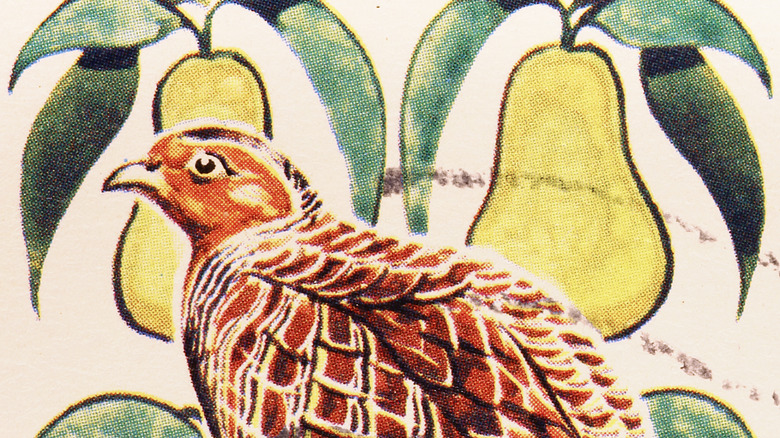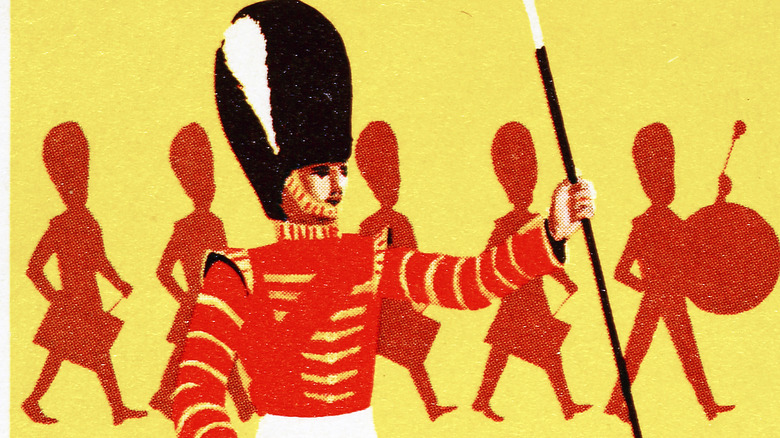The 12 Days Of Christmas Explained
The English Christmas carol "The Twelve Days of Christmas" originated in France and was published in 1780 without any music, according to Christianity.com. Most people are familiar with the song, which features a list of more and more extravagant gifts that are provided on each of the 12 days of Christmas. And the tune that accompanies the song people know today is attributed to English composer Frederic Austin.
The song is based on the concept of the "12 Days of Christmas," also known as Twelvetide, which honors Jesus' birth. These days coincide with Christmas Day through Epiphany. During the Dark Ages, the 12 days allowed parishioners to focus on rededication and renewal, and children would receive small, faith-related gifts. Although the 12 Days of Christmas are a holy time of year connected to the teachings of the Catholic Church, other denominations also celebrate this period.
The Catholic Church used this song to "disguise" its teachings, and each day contains a code that relates to something in the Bible. While it may seem like a whimsical carol, each of the 12 days has a special meaning related to religious doctrine. For example, nine ladies dancing isn't really about women putting on a dance show. Read more about the lyrics of "The Twelve Days of Christmas" below.
'A partridge in a pear tree'
The first line of the carol is, "On the First Day of Christmas my true love gave to me, a partridge in a pear tree." In this case, the partridge represents Jesus Christ, the son of God, according to Hamlet Hub. Sure, the alliteration of "partridge" and "pear tree" is nice, but the reason the bird is a partridge and not, say, an ostrich, is because mother partridges are known to keep predators away from their nests by pretending to be injured. In addition, mother partridges will die to protect their young.
Most people know that Jesus died on the cross for our sins. According to Got Questions, Jesus is born, dies, and resurrected in order to allow sinners to go to heaven. Otherwise, they wouldn't be able to get there. Like the mother partridge dying for its young, Jesus died for mankind. As for the pear tree, it symbolizes redemption, which is defined as "being saved from sin, error, or evil," according to Crosswalk.com. The theme of redemption is featured in both the Old and New Testaments, which segues into our next entry.
'Two turtle doves'
The two turtle doves in the Christmas Carol represent the Old and New Testaments of the Bible, according to Christianity.com. The entirety of the Christian faith and God's plan for mankind are included in the Bible, and the two doves — or the two Testaments — act as a guide for Christians. The Old Testament covers a time period of about 1,000 years from Moses to approximately 400 B.C. According to Compelling Truth, this period includes the creation of the universe as well as the return of the Jews to Jerusalem. Conversely, the New Testament was written later — between A.D. 50 and A.D. 150.
The Old Testament focuses on God's power and actions prior to the birth of Jesus, while the New Testament focuses on the messiah, his life, and his teachings, which are the foundation of Christianity. The New Testament changes the place of worship from a temple or tabernacle to Jesus himself, and he represents the way for believers to reach God. Essentially, the Old Testament is the building block of the New Testament. It's three-quarters of the Bible, and it leads the faithful to Jesus, who is revealed in the New Testament. The New Testament shows how Jesus actualized the predictions about a messiah, and it includes his teachings, miracles, and the words of his followers.
'Three French hens'
The three French hens represent the three gifts of faith, hope, and love, according to ABC News. In 1 Corinthians 13, a passage that is commonly used at weddings, Apostle Paul says, "And now these three remain: faith, hope, and love. But the greatest of these is love." In this chapter, spiritual gifts are ineffective and possibly harmful if they do not come from love. A true Christian love must be unconditional, and it must not be envious, arrogant, or rude.
The biblical definition of faith is "the assurance of things hoped for, the conviction of things not seen," according to Hebrews 11:1 (via Compelling Truth). As for biblical hope, it does not include any doubt. It is a foundation for life and an expectation that God will keep His promises, according to Got Answers. So, why do French hens represent these three virtues? According to the American Ornithological Society, it may be because they were a highly prized meat during feasts in France and England. Interestingly, French hens and their chicken kin are now found in abundance all over the world and are not considered the delicacy they once were.
'Four calling birds' — or 'four colly Birds'
First, the phrase "colly birds" predates "calling birds" by more than 100 years, according to the Library of Congress. "Colly" comes from the Old English word for "coal" and was likely used to describe a raven or a blackbird. Early printed editions of "The Twelve Days of Christmas" also referred to "four canary birds," "four Colour'd birds," and "four curley birds." Indeed, composer Frederic Austin, who wrote the tune you know today, may have been the first person to use the phrase "four calling birds."
So, what does this phrase refer to? The four birds represent the four Gospels and/or the four evangelists, according to Vox. The four gospels are Matthew, Mark, Luke, and John. These sections of the bible include everything that is known about Jesus, including what he said and did. The gospels cover the life, death, and resurrection of the son of God, but in different versions and perspectives. Notably, the settings or order of events are sometimes different. According to Zondervan Academic, they are also theological documents that teach and encourage Christians and try to sway nonbelievers. That's why gospel writers are referred to as "evangelists" who "announce good news" about the resurrection of Jesus and the Kingdom of God.
'Five golden rings'
The five gold or golden rings refer to the first five books of the Old Testament. These books are known as the "Pentateuch" and tell the story of man's fall from grace, according to Shreveport Times. The five books are Genesis, Exodus, Leviticus, Numbers, and Deuteronomy. The Jews refer to these books as the "Pentateuch" — derived from the Greek word for "five volumed" — or the "Torah," according to Bible.org. The five books are the foundation for the theology of the Old and New Testaments and reestablish God's rule over mankind.
Genesis covers the blessing of the seed and the people arising from the seed; Exodus focuses on the redemption of Abraham's seed and the people along with the formation of people with moral, social, and critical judgments; Leviticus is a guide book to help people approach God; Numbers, the fourth book, centers on the Israelites as they wander around after leaving Sinai before reaching the Promised Land; and the final book, Deuteronomy, restates the law, or "second law," according to Insight for Living. It consists of Moses' sermons, which repeat God's commands that the Israelites received decades earlier in Exodus and Leviticus.
'Six geese a-laying'
Genesis, the first book in the Bible, is about creation. The "six geese-a-laying" line refers to the six days of creation, and each day represents an egg that was "hatched" by God, according to Christianity.com. Genesis reveals that God created everything in six 24-hour days, per Answers in Genesis. On the first day, He created the earth in darkness, and then He created light. He called darkness "night" and the light "day." In the original Hebrew, God said "[there] was evening and [there] was morning, one day" and repeated the phrase through the sixth day.
On the second day, he made the sky above the earth and referred to it as heaven. It includes the atmosphere, outer space, and anything that is not physical ground or earth, according to Compelling Truth. On the third day, He made dry land, including continents and ground that could accommodate plants that could bear fruit and seeds. On the fourth day, God made the stars, sun, moon, and other heavenly bodies. On the fifth day, God made birds and sea creatures, although it's unclear why he made them separately from land-dwelling animals. On the sixth day, He made animals that survive on dry land and made man in his image. God also gave himself authority over these creatures.
According to Genesis 1:31: "And God saw everything that he had made, and behold, it was very good. And there was evening and there was morning, the sixth day."
'Seven swans a-swimming'
The "seven swans-a-swimming" refer to the seven gifts of the Holy Spirit and the seven sacraments, according to The Newman Center at Keene State College. Isaiah 11:2-3 talks about the Holy Spirit gifts, which are wisdom, understanding, counsel, fortitude, knowledge, piety, and fear (i.e., respect) for God. According to the Archdiocese of Saint Paul & Minneapolis, wisdom is granted to provide good judgment, separate right from wrong, and promote truth and justice. Understanding provides intelligence and enlightenment, while counsel enables one to teach, inform, guide, direct, and provide others good advice. Elsewhere, fortitude shows one's commitment to God as well as moral strength, courage, and other virtues. Knowledge allows one to study, learn, retain information, and use it constructively. Finally, fear of God is being in awe of and respectful of the Lord, while piety means you are devoted to and obedient to God's will — free of sin — and living a holy life.
These gifts are meant for receptive Christians who pray, avoid sin, and study the scripture as well as perform the sacraments. The sacraments are baptism, communion, confession, confirmation, marriage, anointing of the sick, and holy orders. They are a physical way of achieving inward grace and doing the work of God. For example, being baptized means you join Christianity, while confession leads to forgiveness. During communion, you connect with the grace of Christ, and so on.
'Eight maids a-milking'
The "eight maids-a-milking" represent the eight Beatitudes included in the Sermon on the Mount (Matthew 5:1-12), according to Carolyn's Compositions. The Beatitudes bless the following: those who are poor in spirit; those who mourn; the meek; those who hunger and thirst for righteousness; the merciful; the pure in heart; the peacemakers; and those who are persecuted for righteousness' sake. They represent a moral compass, a way to fight for justice, and one's personal relationship to Jesus. They also describe Christian life and provide "blessed" promises that cause one to rejoice.
The song mentions milkmaids because Christ didn't differentiate between the poor and the wealthy but rather catered to those who would listen to him and accept his grace, according to Christianity.com. Milkmaids had difficult jobs in England, and Jesus cared just as much for them as he did for royalty. Women, not men, milked cows and goats during this time. Interestingly, the phrase "go a-milking" was also connected to romance. In particular, men used the phrase when they wanted to propose to or get intimate with a woman, and it was code for determining whether a woman's feelings were reciprocal.
'Nine ladies dancing'
The "nine ladies dancing" represent the nine fruits of the Holy Spirit, according to The Newman Center at Keene State College. Featured in Galatians 5:22-23, the nine fruits are: love, joy, peace, patience, kindness, goodness, faithfulness, gentleness, and self-control. Christians, under the guise of the Holy Spirit, will exhibit these types of virtues. Love refers to the love of God and your neighbor, which is unconditional and without the expectation of anything in return, according to The Catholic Spirit. You achieve joy by relationships with God and other people, and it encompasses truth, honesty, and integrity.
Peace involves harmony, justice, equality, respect, and honesty. Patience means you suffer without complaint, have self-restraint, and endure with resolve and determination; indeed, it means sacrificing for another person's benefit. Kindness means being nice and friendly to other people — you are respectful, cheerful, agreeable, caring, and pleasant. Generosity is sharing and being selfless with friends, family, strangers, and others in need. This fruit involves physical giving as well as sharing time and energy.
Faithfulness is showing loyalty, fulfilling commitments, completing projects, observing vows, and holding up one's word. Gentleness is being sensitive towards others and caring for their welfare and involves humility, affection, and tenderness. Lastly, self-control is controlling oneself instead of being controlled by outside forces, events, or people. You remain calm and even-tempered during a crisis.
'Ten lords a-leaping'
The "ten lords a-leaping" represent the 10 Commandments, according to Christianity.com. According to Bible Info, they are the following: "You shall have no other gods before me"; "You shall make no idols"; "You shall not take the name of the Lord your God in vain"; "Keep the Sabbath day holy"; "Honor your father and your mother"; "You shall not murder"; "You shall not commit adultery"; "You shall not steal"; "You shall not bear false witness against your neighbor"; and "You shall not covet."
The first commandment prohibits the invention of imaginary and false gods, while the second forbids the worship of false deities or representations of the one true God. The third commandment means not using God's name in profanity or carelessly using it in slang, and the fourth involves recognizing and observing God's Holy Day in your home.
Elsewhere, the fifth commandment centers on loving, respecting, and being obedient to one's parents, and the sixth means not killing another human being. The seventh commandment is adhering to one's marital vows and being committed to one's husband or wife, while the eighth is being honest and not stealing from other people. The ninth commandment prohibits bribery, forgery, libel, slander, etc., and the tenth and final commandment prohibits lusting after things your neighbor possesses.
'Eleven pipers piping'
According to The Newman Center at Keene State College, the "eleven pipers piping" represent the 11 faithful disciples, excluding Judas Iscariot. These disciples gave up everything in order to follow Christ. These men were commoners — such as farmers and fishermen — and not wealthy and influential. Jesus spent time teaching them to carry on his work, according to Crosswalk.com. The disciples are Peter, James, John, Andrew, Bartholomew (Nathanael), James the lesser, Judas Iscariot, Judas (Thaddeus), Matthew (Levi), Philip, Simon the Zealot, and Thomas.
Peter denied Christ three times after his arrest and following his own arrest asked to be crucified with his head down because he didn't think he was worthy to be crucified like the son of God. Andrew was passionate about sharing the word of God and courageously met crucifixion. John wrote a large portion of the New Testament, including the book of Revelation. Little is known about James the Less and Philip, and James is the only disciple to have his martyrdom recorded in scripture.
Interestingly, Nathanael may have translated the book of Matthew into the Indian language and died a martyr after being crucified and beheaded. Matthew was a tax collector who brought the word of god to Ethiopia and Egypt. Thomas was devoted to Christ, and he may have been responsible for bringing Christianity to India. Simon the Zealot was devoted to Christ and was reportedly crucified in England. Judas was clubbed to death for his beliefs, and finally, Judas Iscariot was a traitor who betrayed Christ.
'Twelve drummers drumming'
According to Project Britain, the 12 drummers represent the 12 points of doctrine in the Apostles' Creed. Per Reformed Church in America, it reads: "I believe in God, the Father almighty, maker of heaven and earth; And in Jesus Christ, his only Son, our Lord; who was conceived by the Holy Ghost, born of the Virgin Mary, suffered under Pontius Pilate, was crucified, dead, and buried. He descended into hell. The third day he rose again from the dead. He ascended into heaven, and sitteth on the right hand of God the Father almighty. From thence he shall come to judge the quick and the dead. I believe in the Holy Ghost, the holy catholic Church, the communion of saints, the forgiveness of sins, the resurrection of the body, and the life everlasting. Amen."
The creed was written approximately 300 years after Christ was born and represents the foundation of the Christian faith. Today, it still acts as a statement of faith and is used in worship in many different churches.












